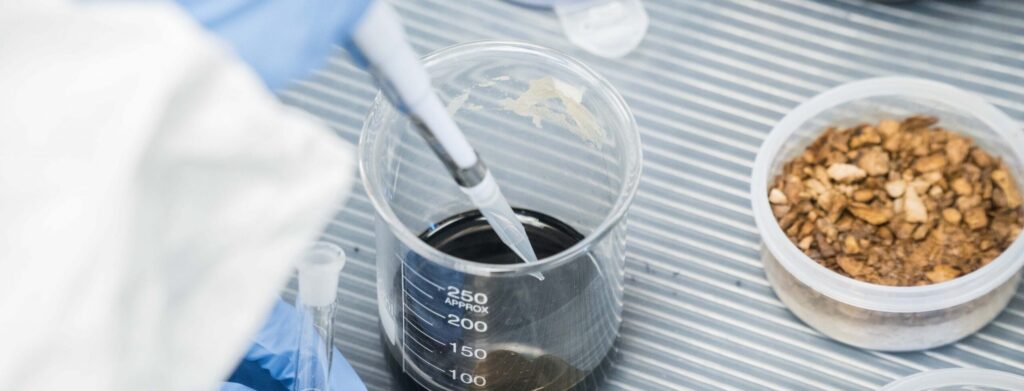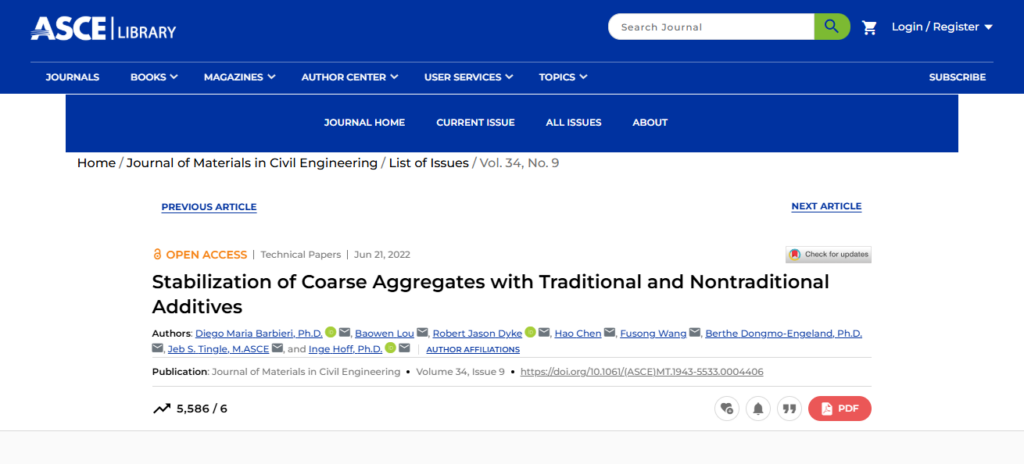
In the mining industry, maintaining functional, durable, and cost-effective unpaved haul roads is essential for efficient operations, minimizing maintenance costs, and reducing environmental impact. Traditional stabilization methods often involve the use of expensive aggregates, cement or other chemical agents, but these can be costly and environmentally hazardous. Recent research has highlighted the potential of natural, in-situ cohesive clays as an ideal alternative for road stabilization, offering several advantages over conventional materials.
 In collaboration with a Postdoctoral Researcher from the Norwegian University of Science and Technology (NTNU), Cypher Environmental spent two years investigating and testing the various stabilization technologies for coarse-graded road unbound layers. Our research, which included a rigorous series of laboratory tests and field trials, highlighted the exceptional performance of our innovative cohesive clay binding stabilization solution, DUST/BLOKR®/SB. Our use of cohesive clays as a binding solution was incorporated into the study alongside other stabilizers, providing a comprehensive comparison of their effectiveness in improving road durability.
In collaboration with a Postdoctoral Researcher from the Norwegian University of Science and Technology (NTNU), Cypher Environmental spent two years investigating and testing the various stabilization technologies for coarse-graded road unbound layers. Our research, which included a rigorous series of laboratory tests and field trials, highlighted the exceptional performance of our innovative cohesive clay binding stabilization solution, DUST/BLOKR®/SB. Our use of cohesive clays as a binding solution was incorporated into the study alongside other stabilizers, providing a comprehensive comparison of their effectiveness in improving road durability.
The benefits of stabilization extend beyond mere structural improvement. Stabilized roads exhibit enhanced resilience against common issues such as dust generation, potholes, and rutting—problems that often plague unpaved roads. Additionally, stabilization methods like DUSTBLOKR®/SB that use in-situ cohesive clays contribute to environmental sustainability by reducing the need for frequent road repairs and decreasing dust emissions, which can have detrimental effects on surrounding ecosystems.
Laboratory Testing and Results: Enhancing Road Performance Through Clay Binding
The research aimed to assess the effectiveness of different stabilizing additives and techniques, focusing specifically on their ability to improve the durability and performance of coarse-graded roads. The study utilized three distinct laboratory tests to evaluate the properties of these stabilization methods:
- Repeated Load Triaxial Tests (RLTT) to determine the stiffness and potential for permanent deformation under repeated stress.
- An altered rolling bottle test to evaluate the stripping potential of each stabilizing additive and its ability to resist water-induced damage.
- Microscope analysis to examine the coated surfaces of the aggregates and assess the degree of stabilization achieved.
The results from the RLTT revealed that our DUST/BLOKR®/SB solution provided the highest resistance to permanent deformation, outperforming all other stabilizers tested. This indicates that the treatment significantly enhances the performance of coarse-graded roads, especially in regions with fluctuating weather conditions and heavy traffic.
An abstract of the research has been included below:
Stabilization of Coarse Aggregates with Traditional and Non-Traditional Additives
This thesis investigates the use of clay-rich materials as a binding agent for unpaved roads. The purpose of the research is: 1) to help determine the optimum methods of using local natural clay-rich materials to securely bind and stabilize an A-Base gravel aggregate, and 2) determine the effect on binding strength and durability as a result of varying the construction and materials parameters. It has been demonstrated that with proper materials and protocols, roads can be constructed that are durable, long-lasting, low-cost and environmentally safe with superior performance characteristics. The process utilizes the electronic properties of reactive clays, to make them a strong, cohesive bonding agent for an appropriate aggregate material. This reduces water absorption and retention, and the swelling capabilities that ordinarily render clays a poor construction material. Organic catalysts help with the effective expulsion of water, enhance compaction and densification, and promote electronic bonding of clay particles to each other through interlayer positively charged cations and polymers.
Laboratory testing was carried out at the Brandon University Micro-Analytical Facility and Geotechnical Labs in order to better understand the effects of varying parameters on the characteristics and performance of clay bonded materials. Observed increases in density (6%) and corresponding decreases in optimum moisture content (OMC, 16%) in proctor tests completed on a local clay material (CL) comprised of 30wt% montmorillonite and 7.3wt% illite, were observed when treated with an organic catalyst. Penner clay, a medium-plasticity clay from the RM of Cornwallis, MB, was subjected to California Bearing Ratio (CBR) testing in both untreated and treated states and experienced a 14.2% increase in CBR % (bearing strength) when treated. Penner clay was also used to construct cylindrical slabs that were subjected to various strength and bonding tests, including semi-confined compression testing using a Hoskins Scientific 10,000lb Load Frame and a button piston with a one square inch surface area. When compacted with varying amounts of energy, all clay slabs that were treated reached catastrophic failure (collapsed under pressure) at higher load pressures (PSI) than untreated clay slabs. Increases in the maximum semi-confined compressive strength were as high as 19.5% during semi-confined compression testing. Treated clay slabs were observed to absorb ambient moisture at a reduced rate (19.4%) compared to untreated clay slabs.
It was observed that curing time and compaction were the two most important factors controlling the strength of treated clay slabs. A 356% increase in strength was observed between a one day and 7 day curing, and a 124% increase in strength occurred on increasing compaction energy from 10 proctor hammer blows to 40. The apparent modest gains in strength between treated and untreated slabs are an artifact of laboratory testing vs actual road performance. To better duplicate road conditions, continuous compaction was employed during the curing process of CBR tests, which resulted in an 80% gain in strength for treated CBR specimens compared to CBR specimens not subjected to continuous compaction. Even though the bearing strength of cured (dried) cohesive-clay rich materials was quite strong without being treated with the catalyst, the bonds are transitory and quickly broken upon contact with water, and consequently strength is rapidly lost. In contrast, catalyst-treated materials and properly constructed roads maintain the electronic bonding of clays and strongly resist water ingress. Consequently, regardless of other factors, it is the durability of the clay bonding that is the single most important factor in the long-term durability and performance of clay-bonded aggregate roads.
An important aspect of the research was field trials, where actual roads were constructed, tested and monitored according to the parameters discussed in this investigation (Appendix A) and in the Manual for Clay Stabilization of Unpaved Gravel Roads (Mumin and Cram, 2020). These test roads were re-constructed with wearing surfaces comprised of clay-rich aggregate materials, treated with a non-toxic organic catalyst, and then monitored over a period of several years. All stabilized roads that were constructed in the Brandon, MB area, were subjected to dynamic cone penetrometer (DCP) tests and produced excellent bearing strengths with CBR values >50. One particular stabilized test road, Patricia Ave. in the city of Brandon, MB, experienced a 340% increase in bearing strength compared to the pre-existing in-situ road materials that had been stabilized by standard techniques. In addition to significant decreases in dust generation from traffic, there are major reductions in pot holes, wash boarding and rutting, and no frost damage has ever been recorded on a properly stabilized road. For high traffic and high-maintenance roads, substantial cost savings can be experienced due to a significant reduction in required road maintenance and reduced vehicle wear.
The full study was published by the American Society of Civil Engineers (ASCE) and is publicly available:
Originally published August 23, 2022. Updated January 20, 2025.


